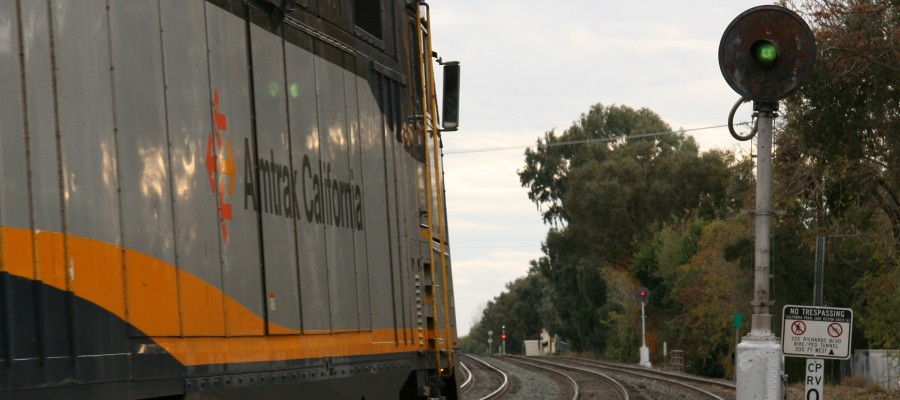“If a signal is not all red, then it is not red at all.”
[NOTE: I reposted this article by AA Krug here after it suddenly disappeared from its URL in early 2016.]
Railroad signals have fascinated me from when I was a child. I don’t know why. Maybe it is the colored lights. Maybe not, highway traffic signals have no appeal to me.
When writing about my experiences on the railroad I often mention various signal indications. Some readers have asked me to explain “signals” to them. I have been told RR signals seem to be an arbitrary collection of colored lights that make no logical sense and simply have to be memorized. With this page I hope to show that they are not arbitrary and there really is a “system” to this madness.
First lets discuss definitions.
- When talking about RR signals you need to know that what a signal looks like, Yellow over Green over Red for example, is called the ASPECT.
- What that signal is called is its NAME. APPROACH MEDIUM for this example.
- The INDICATION of a signal is not how it appears but rather what you must do when encountering that signal. PROCEED PREPARED TO PASS NEXT SIGNAL NOT EXCEEDING 30 MPH for example.
So we have ASPECT, NAME, and INDICATION. These are the formal definitions. However in actual practice non-signal department railroad workers often use the word Indication in referring to any of these three attributes of a signal.
“What signal indication did you have?”
“Approach Medium.”
“What signal indication did you have?”
“Flashing Yellow.”
Technically both of these answers are wrong. In the first case he answered Approach Medium which is the Name not the Indication. In the second case he answered Flashing Yellow which is the Aspect not the Indication. As I said, the actual use of the word indication is often blurred by crews.
I grew up in Miamisburg, Ohio, a small town south of Dayton. There were two railroads that ran through Miamisburg, The New York Central (NYC) and the Baltimore and Ohio (B&O). Each railroad used a difference signal system so I was exposed to, and could readily see, the similarities and differences of the two systems. The B&O system was fairly unique. But the NYC system’s general principles can be applied to most North American railroad signal systems.
The New York Central Railroad (NYC) had a double track mainline that ran through my home town. It was signaled for movement in only one direction on each of the two tracks. It was a pure Automatic Block Signal system (ABS) system. Manually operated crossovers and manned interlocking towers were located approximately every 15 miles. I learned about RR signals by observing signal appearances as a train approached, passed or crossed over, and continued out of sight down the track. You can learn a lot about RR signals simply by observing.
The NYC signal system was very straight forward. At first glance at the rulebook it appears that the signals are an arbitrary combination of red, yellow, and green lights. But it was not arbitrary, there was a method to the madness. Once you realize what that method is you can then know the name and indication of almost any signal in this system just by looking at it. You do not need to memorize all the different signals.
Where I grew up, and eventually worked on the railroad, the NYC used at least two signal lights on every signal post. Many locations had 3 but 2 was the minimum. For initial purposes of this discussion I will use only 3 head signals. I will show later how 2 head, and even 1 head, signals fit into the over all scheme.
Three Heads, Three Speeds
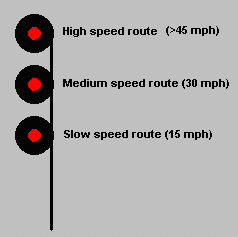 This first diagram shows a typical 3 head color light signal. The key is in understanding that each head governs a specific speed route. The higher on the pole the higher the permitted speed.
This first diagram shows a typical 3 head color light signal. The key is in understanding that each head governs a specific speed route. The higher on the pole the higher the permitted speed.
- The top head governs the HIGH speed route. This would be “straight ahead”. Not diverging through any switches. Track speeds would typically be greater than 45 mph and may be over one hundred mph.
- The middle head governs the MEDIUM speed route. It would typically be used when diverging through relatively long track switches which are designed for speeds in the 30 mph range.
- The bottom head governs movement on the SLOW speed route. That would be diverging through shorter switches that are only safe to traverse at 15 mph or slower.
Three Colors, Three Meanings
The second thing to know is what the colors mean. The colors have the same meaning no matter which head they are in.
 Green means that at least TWO blocks beyond this signal are clear.
Green means that at least TWO blocks beyond this signal are clear.

Yellow means that only ONE block beyond this signal is clear and this route is impassable at the next signal.
 Red means that this route is impassable.
Red means that this route is impassable.
It is that simple. Three heads, each which can show only one color at a time. The higher the head is on the pole the higher the permissible speed. Three colors. Each has the same meaning regardless of its location in the hierarchy.
Three Heads and Three Colors
Now lets look at how these facts apply to multiheaded signals. The most restrictive case is when all 3 heads are red. This indicates that all 3 routes are impassable at this signal.

At the other end of this extreme is the case where the highest speed route is clear for at least two blocks.

If the highest speed route is only clear for one block then the top head will be yellow.

The same logic is applied to the center, Medium speed, head.


And also to the bottom, Slow speed, head.


If a highway traffic light changes from green to yellow to red in front of your automobile you are able to stop your car before passing the red signal. Trains cannot stop quickly. It takes one mile or more to make a service stop from track speed. At any place a signal requires a train to stop, that train’s engineer must be warned of this requirement far enough in advance to enable him to stop the train. That is the purpose of the yellow signals. They warn the engineer that he must be prepared to stop at the next signal beyond the yellow one.
By now you should be able to see how simple this basic system is. There is nothing mysterious or arbitrary about it after all.
We continue to build on these basic premises.
I said that any time a train will be required to stop it must be given sufficient advance warning. But it is not just when they are required to stop. Any place a signal requires a train to reduce its speed below the maximum track speed the engineer must be warned far enough in advance to enable him to slow the train to the required speed. The Approach signal below tells the engineer the high speed route is impassable at the next signal. Since no other route is showing a more favorable aspect he must be prepared to stop at the next signal.

What if the high speed route at the next signal is impassable but a slower speed route is lined through OK? The engineer must still be warned of the impassable high speed route ahead so the high speed head, the top head, must be yellow. But he can also be told of the lower speed routing so he knows he only has to slow at the next signal not stop at it.

In the signal above the yellow high speed head tells him the block beyond it is clear up to the next signal. He would have to be prepared to stop at the next signal except the middle, Medium speed, head is green. Since green means a route is clear for at least 2 blocks he knows he can proceed on the Medium speed route at the next signal. Thus this signal informs him he only needs to slow to Medium speed for the next signal, not stop.
The signal above introduces a new twist. It appears as if two routes are passable at once, the high speed route and the medium speed route. Because of the physical nature of track switches obviously only one route can be lined at a time so what is going on here? When dealing with signals that have more than one non-red head, you may operate the train through the block that signal governs at the speed of the highest non-red head. In the case of the Approach Medium signal above, the train may continue at maximum speed through this block but must reduce to Medium speed at the following signal.
If it is the Slow speed route that is lined at the next signal then he would be informed of that situation in a similar manner with the following signal.

With the above signal the engineer knows he must reduce to Slow speed at the next signal but will not be required to stop there.
Three Heads, Five Speeds?
So far we have been dealing with 3 speeds corresponding to the 3 heads. Maximum track speed (50mph or greater), Medium speed (30mph), and Slow speed(15mph). A fourth speed is called Limited speed and on the NYC it was defined as 45mph. At locations where many trains routinely diverge through a switch or switches, such as important junctions, the RR may not want to slow every train to 30 mph for Medium speed switches. The RR may choose to install higher speed switches. Both time and fuel can be saved by allowing trains to diverge at higher speeds.
How do you show this fourth speed on a 3 head signal? The answer is to apply a “marker” to the signal to “bump up” the Medium speed aspect to Limited speed. On the NYC this was done by flashing the center, Medium speed, head. The “rays” around the center head in the figure below indicate that light is flashing.



Flashing a light on a signal “upgrades” that signal to a less restrictive signal than it would otherwise be if the light were not flashing. We will see this flashing upgrade on other signals later on.
The 5th speed is Restricted speed. Restricted speed is defined differently by different railroads but the core element is that a train must be operated in such a manner that it can be stopped before it hits another train or anything else on the track. Restricted speed usually also has a maximum allowable speed associated with it. Maximum speeds for Restricted speed varies from 10 mph to 20 mph depending on the individual railroad. Restricted speed is shown by one of 3 methods. The first way is to use a Lunar colored light instead of a red light. Lunar color is a bluish white or a silverish white. If any one of the red lights in a 3 head signal is replaced by a Lunar light it changes that signal from a Stop to a Restricted signal.

The head position of the Lunar light usually, but not always, indicates the route that you will be taking. But it doesn’t matter because the maximum speed for Restricted speed regardless of which head it is on is at or below Slow speed.
The second method used to change a Stop signal to a Restricted signal is to flash one of the red lights.

(When ever a signal has a light that is flashing it means that signal is less restrictive than it would be if the light were not flashing. Just like a flashing light on the Medium speed head upgrades a Medium speed signal to a Limited speed signal, a flashing red light upgrades this signal from a Stop signal to a Restricted signal.)
The third method is to apply a number plate to the signal post.

When this method is used it is usually called a Stop & Proceed signal. Trains must stop before passing the signal but then may proceed at Restricted speed. However some railroads do not require the stop. Trains on those railroads may pass this signal at Restricted speed without stopping. In these cases it is usually called a Restricting Proceed.
On some of the railroads that use the Stop & Proceed indication there may be certain locations, such as steep grades, where they do not want trains to stop. In these cases they can convert a Stop & Proceed signal into a Restricted signal by applying a “Grade” marker sign to the signal post. Trains encountering this signal are not required to stop before proceeding. They may continue to move past the signal at Restricted Speed.
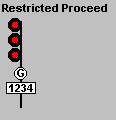
One Head, Two Heads, or Three Heads
At most locations on the railroad where signals are located there is no choice of routes. The only route available is straight ahead on the main line. Since there is no Limited, Medium, or Slow Speed routes there is no need to include provisions on the signal itself to display aspects governing movements on those routes. Thus the bottom two heads can be eliminated.
Where ever you see a signal with just one head that head represents the top most head on a signal pole. Thus it is always the High Speed head.

The signal above is the same as the signal below.

Similarly the following signals are the same.


As are these:


At some locations there may be a choice of the high speed route and a Medium or Limited speed route but no Slow speed route.. At these locations only the top two heads are needed. The signal names and meanings are the same as with 3 heads. Just the bottom, Slow Speed, head is missing.









Where a lot of fast heavy trains are run or the block lengths are short the railroads need to alert an engineer earlier than just one signal away of a requirement to slow down ahead. Therefore they came up with the Advance Approach signal. An Advance Approach told the engineer that he needs to be prepared to stop at not the next signal but the one after that. On the NYC through my hometown this aspect was Yellow over Yellow and is the first aspect that breaks with our common “system” in that it is arbitrary.

The yellow over yellow aspect is the one aspect that varies the most in meaning from railroad to railroad. Depending upon the individual RR I have seen it mean Advance Approach, Approach Restricting, or Approach Diverging. Because the double yellow aspect was already in use for other indications on some RRs they use the Approach Medium aspect as a kind of Advance Approach signal.

They use it to warn the engineer in advance that the next signal he gets may be an Approach signal. The Approach Medium signal tells the engineer that the High Speed route is clear for only one block ahead and he must reduce to Medium Speed at the next signal. This forces the engineer to slow down to 30 mph at the next signal where he will normally have an Approach indication.

The Approach tells him he must be prepared to stop at the next signal. Since the previous Approach Medium signal already had forced him to slow to 30 mph an easy and smooth stop can be made at the next signal.
While we normally think of an Approach Medium signal leading us to a Medium Clear or Medium Approach at the next signal indicating we will be diverging through a Medium Speed switch, there is nothing inherent in the system that says we WILL be diverging. The signal simply says that we must be down to Medium Speed at the next signal. So the Approach Medium signal works just as well as an Advance Approach in this respect.
Railroads in their eternal pursuit of cost savings do not want the expense of installing and maintaining two signal heads at every signal location just to provide this “Advance Approach” Approach Medium warning. So they devised another way of giving the Approach Medium aspect on a single head signal. They used the flashing light method to once again “bump up” an otherwise more restrictive aspect. They flash the normally steady yellow light of an Approach signal.


When the top yellow light is flashing it upgrades the signal from an Approach indication to an Approach Medium indication.
In the continuing pursuit for the elimination of unneeded signal heads some railroads eliminated the center head if there was no Limited or Medium speed route at a location. This left an odd looking larger than normal gap between the heads that distinguished these 2 headed signals from their two headed Limited and Medium speed counterparts. Where you see a larger gap between heads on a signal pole the lower head represents the Slow Speed route.



Safety on the New York Central
Many roads used only one head on their block signals where there was no choice of routes. Today most RRs have gone to a “minimum heads” configuration and that means only one head at these signals. But the NYC of my youth used a two head minimum for added safety. Even at locations where the only route was straight ahead on the mainline they always used a second head. That second head of course never showed anything but red since there was no choice of routes. In fact it contained only a red light. (Some locations that needed to show the double yellow Advance Approach also had a yellow light in the lower head but most did not). So why put a second head on each signal if it was not needed? The answer is safety. When an engineer passes an Approach signal which requires him to stop at the next signal he has to find that next signal. Not difficult if he knows the road and visibility is good. But in heavy fog or snow it is easy to get “lost” by a few hundreds or a thousand feet. Finding that next red signal in the fog may be difficult, especially if it happened to be burned out! By the time the dark signal is seen it may be too late to stop. So the NYC used the second red head as a sort of signal marker. An aid to locating the signal in the dark or fog in cases where the primary head’s light was burned out.
Since each signal had at least two heads the NYC could go one step further. Normally the only difference between a Stop signal and a Stop & Proceed signal was the absence or presence of a number plate on the signal post. Again in bad weather or at night an engineer had to get close to the signal to see if it had a number plate on it or not. Reflective signs had not been invented yet and headlights were not as good as today’s. To aid in determining if the signal was a Stop (and stay) signal or a Stop & Proceed signal the NYC staggered the two heads on the Stop & Proceed signals.
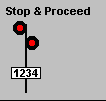
Now an engineer could tell from a long distance which type of signal he was looking at. Note that this staggering of heads only makes a difference when both lights are red. All other aspects and indications are unaffected by it just as they are unaffected by the presence or absence of a number plate.
Our Signal System
Before reading this page you may have looked at the following groups of signals and been overwhelmed. You might have thought it was just a lot of arbitrary color light combinations that you would have to memorize. Hopefully now that you have read this page you know the following.
- Three Heads
- The High speed head
- The Medium speed head
- The Slow speed head
- Three Colors
- Red means route impassable
- Yellow means clear for one block
- Green means clear for two blocks
- Flashing a light upgrades the signal
With that knowledge you should be able to determine what is required for each of the signals shown below. Combining all that we have learned into one coherent signal system yields the following.














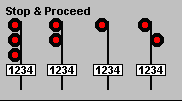

See I told you it all made sense. Except for the somewhat arbitrary double yellow Advance Approach it all follows a common pattern.
Today’s Signals
Having shown you how all these signals came about and how neatly they fit into a system I now must give you the bad news. It seldom works that way now. Not all RRs used an NYC system. The NYC system described above is usually referred to as a SPEED SIGNALING system. Why should be obvious, the signals tell an engineer what the maximum speed is at this signal or what maximum speed he must be doing at the next signal. Other RRs used speed signaling systems that were similar to the NYC but that had their own idiosyncrasies. I have already mentioned how various RRs had differing meanings for the double yellow aspect. Some of the other aspects also have different meanings on different RRs. The definition of each speed, Limited, Medium, and Slow, may be different from the 45 mph, 30 mph, and 15 mph given in the NYC example. However you should find what you learned here about the former NYC system to be of great value in helping you to understand these other systems.
Some railroads did not/ do not use speed signaling. They use a system referred to as ROUTE SIGNALING. On these systems the signals do not give a specific speed limit. Instead they indicate whether or not you are going to go on the straight route or the diverging route. Many of the signal aspects, names, and indications are the same as, or closely related to, the same ones in a Speed Signaling system. Especially those that have nothing to do with speeds such as Clear, Approach, Restricted, Stop & Proceed, and Stop. But the aspects of speed signals with names containing the words Limited, Medium, or Slow usually have slightly different meanings in a route signaling system. For instance, instead of red over green being Medium Clear it is DIVERGING CLEAR. The signal tells the engineer he is going to diverge but it doesn’t tell him at what speed he must diverge. The speeds for diverging routes are given in the employee Timetable and Special Instructions for that subdivision. The engineer must KNOW what speed is permitted diverging at this location. This is not as bad as it first seems because on any given subdivision most of the diverging speeds will be the same or only a few different ones. On the Bighorn Subdivision where I work we have only one diverging speed. All of our CTC siding switches and junction switches are 25 mph. However part of my run is on the MRL and they have three diverging speeds depending upon where you are at. The east switch and crossover at Huntley are 30 mph. The west switch at Huntley and the switch at end of double track at East Billings are 35 mph. The crossover at Shilo is 20 mph. Under a route signaling system you just have to know these things.
While all signal systems started out with a great deal of logic in their aspects and indications most have since been “bastardized” badly. Mergers brought differing signal systems into the same fold. The Burlington Northern merger combined the former NP, GN, CB&Q, SP&S, and Frisco railroads. All these RRs had signal systems that varied from the others’. In some cases the differences were slight but in others they were great. The BN wanted a common signal system but did not want to make great, expensive, changes to the systems in the field.
In some places simply changing the color of a lens would match one system to the other. In other locations perhaps adding a flasher or removing a flasher would do it. But the entire mix of systems could not be fully combined without making changes to the rules describing aspects, names, and indications of signals. The merger of the BN and the Santa Fe into the BNSF further complicated the matter since BN and ATSF signals were different. What results is a system today that little resembles the original systems.
The combination of the speed signaling systems with the route signaling systems resulted in the most discrepancies. The compromises made to unify the various systems has resulted in the loss of the original logic in those systems. Some remnants of the original signal philosophies remain but overall you can no longer “think it out”, you just have to memorize the signal rules.
The BNSF corporate web site has the employee Timetables & Special Instructions and rulebooks available on line. (BNSF site. Look under Employees and Rulebooks). One of those documents is the BNSF Signal Sheet.
[Edit: Here are BNSF signal rules as of August 2022.]
If you want to know exactly what current BNSF signal rules are I suggest you download that sheet. If you want to know what the signal rules are for other RRs there are also sites catering to those. In addition the Altamont Press series of timetables have signal rules in them.
Different Ways to Display the Same thing
In the very early days of railroad signaling lights were not bright enough to see or distinguish the different colors during daylight. Instead of lights the daytime aspect was shown by a wooden arm. These signals are called semaphores. If the wooden arm or blade was in the vertical position it meant green. If it was at a 45 degree angle it meant yellow. And if it was horizontal it meant red. For night time aspects the movement of the arm brought a green, yellow, or red lens in front of a single dim light.


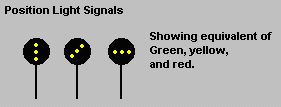
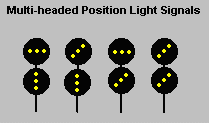
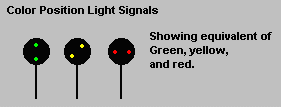
The Naming of Signals
Like the signal aspects the signal names also follow a pattern. Unfortunately it is not quite as straight forward as the aspects. Each signal should tell you two things:
- The maximum speed at this signal.
- The maximum speed at the next signal.
Signal names should be something like this.
Maximum to Maximum
Maximum to Limited
Maximum to Medium
Maximum to Slow(
Maximum to Restricting
Maximum to Stop
Limited to Maximum
Limited to Limited
Limited to Medium
Limited to Slow
Limited to Restricting
Limited to Stop
Medium to Maximum
Medium to Limited
Medium to Medium
Medium to Slow
Medium to Restricting
Medium to Stop
Slow to Maximum
Slow to Limited
Slow to Medium
Slow to Slow
Slow to Restricting
Slow to Stop
In the late 20th century the Canadian railroads changed their signal names to a pattern similar to the above though in my opinion they did not go far enough. U.S. railroads, however, have not followed suit and have kept their, in my opinion, inferior signal naming system.
If a track ahead is unoccupied by other trains and all switches in that route are properly lined then the track, or block, is said to be clear. For clear blocks the maximum speed permitted is usually included in the signal name. LIMITED CLEAR, MEDIUM CLEAR, and SLOW CLEAR for example. However for the highest speed signal the railroads chose not to include the speed in the name. Thus the high speed route is simply CLEAR instead of HIGH CLEAR or FAST CLEAR. This may be because the earliest signal systems did not have more than one head and did not give speed or route information so the old names just carried over.
However, in modern systems there are speed indicating signals so if you are approaching a signal that requires a speed other than maximum track speed you must be informed of that fact. APPROACH LIMITED means that the next signal will be a Limited speed signal and you must reduce to Limited speed before passing that next signal. APPROACH MEDIUM means that the next signal will be a Medium speed signal and you must reduce to Medium speed before passing that next signal. APPROACH SLOW means the next signal will be a Slow speed signal and you must reduce to Slow speed before passing that signal. APPROACH RESTRICTING means that the next signal will be a Restricting signal and you must reduce to Restricted speed before passing that next signal.
If a track is blocked ahead account of another train occupying it or a switch improperly lined the signal will be red and its name is STOP. We do not say it is a HIGH STOP or a MEDIUM STOP or a LOW STOP. Since stop means no movement no speed statement is necessary. It is just STOP for all of them.
If the top head is yellow it is telling you that this block is clear but the next block is impassible and you will have to stop at that next signal. Following the same logic as Approach Limited, Approach Medium, Approach Slow, and Approach Restricting a yellow signal should be named APPROACH STOP. But again the railroads dropped the STOP and just named it APPROACH. In the earliest signal systems there were no speed indications so the only thing you could be approaching was a stop so it was unnecessary to include the word stop in the name of an Approach signal.
At this point we have covered the naming of the following signals and it should be apparent what they mean. The words in parenthesis are implied.
(high speed) CLEAR
LIMITED CLEAR
MEDIUM CLEAR
SLOW CLEAR
APPROACH LIMITED
APPROACH MEDIUM
APPROACH SLOW
APPROACH RESTRICTING
APPROACH (stop)
Unfortunately it is not quite that easy. All of those approach signals above should have a speed indication in front of the word approach to tell you what the allowable speed is AT THAT SIGNAL.
The “approach” signals above should be like this but they are not.
MAXIMUM APPROACH LIMITED
MAXIMUM APPROACH MEDIUM
MAXIMUM APPROACH SLOW
MAXIMUM APPROACH RESTRICTING
MAXIMUM APPROACH (stop)
I say this because those are not the only signals that have the word approach in their names. We also have signals named:
- LIMITED APPROACH LIMITED meaning you must pass this signal at Limited speed and also pass the next signal at Limited speed.
- LIMITED APPROACH MEDIUM means to pass this signal at Limited speed and pass the next signal at Medium speed.
Similarly we have:
- LIMITED APPROACH SLOW
- MEDIUM APPROACH MEDIUM
- MEDIUM APPROACH SLOW
The flip-flop signal names.
A lot of new railroaders have trouble with the signals that have the word approach in their names. Looking at the above lists it seems simple enough. If the name has approach in it then it means you are approaching a signal of that name and speed requirement. However remember the case of the simple APPROACH signal. That one means approach a stop signal. It should be named MAXIMUM APPROACH STOP but is not, it is just APPROACH. Similarly signals that require a speed limit but also lead up to a stop signal use the word approach but drop the final word STOP.
LIMITED APPROACH
MEDIUM APPROACH
SLOW APPROACH
All of the above signals require you to proceed at the named speed at this signal and be prepared to stop at the next signal.
General naming conventions.
- If the FIRST word of the name is a speed, that speed applies AT THAT SIGNAL.
- If the FIRST word in the name is approach, it means the speed following the word approach is required AT THE NEXT SIGNAL.
- If the LAST word in the name is APPROACH, it means you are approaching a STOP signal.
LIMITED CLEAR
MEDIUM CLEAR
SLOW CLEAR
LIMITED APPROACH LIMITED
LIMITED APPROACH MEDIUM
LIMITED APPROACH SLOW
MEDIUM APPROACH MEDIUM
MEDIUM APPROACH SLOW
LIMITED APPROACH (stop)
MEDIUM APPROACH (stop)
SLOW APPROACH (stop)
You should now know the difference between APPROACH MEDIUM and MEDIUM APPROACH?
“If a signal is not all red, then it is not red at all.”
The above quote appeared at the very beginning of this page. It should now be apparent to you what it means. Unless all of the lights in a signal are red, the signal is some form of proceed signal and it does not require you to stop at it.
Created 06-06-2001
Updated 11-06-2006
